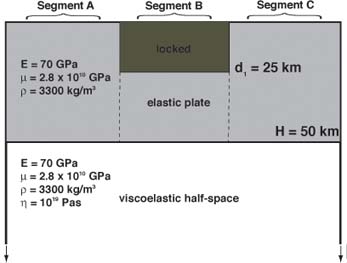Viscoelastic Movies
Bridget Smith and David Sandwell
in preparation, 2004
Here we present a 3-D simulation of the earthquake cycle that includes
multiple fault elements and explores postseismic deformation for
intermediate time scales following an earthquake. The basic model
consists of a fault system of three independent segments, A, B, and C,
that are imbedded in a 50 km thick elastic plate that is loaded by 40
mm/yr of relative plate motion. Between earthquakes, the middle fault
segment, B, is locked from the surface to a depth of 25 km, below which
deep, secular slip occurs. The two adjacent fault segments, A and C,
are allowed to slip completely to the surface with no locking,
simulating uniform fault creep.

|
|
In this model, we assume that the
fault system is a mature one (geologically evolved), where t = 0 years
represents the time of model initiation assuming a full secular plate
step is already in place. This model spans 300+ years, where the first
100 years include secular tectonic loading and 4 m of slip will
accumulate on the locked segment. At t = 100 years, we simulate an
earthquake by initiating coseismic shallow slip (depths < 25 km) on
segment B. Following this event, postseismic deformation due to
viscoelastic relaxation will occur. We capture single-year snapshots at
5-year increments for both 3-D velocity and Coulomb stress. Alternative
velocity models for H= 25km and 100km (d=25km) are also shown below.
Coulomb stress models show the postseismic stress response both with
and without secular accumulation following the event. |
|
